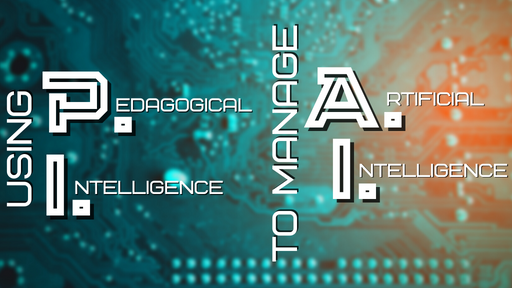Dana Dawson, Ph.D.

Over the course of this series, we have presented what we’re calling pedagogical intelligence as an approach to addressing the impact of technologies such as ChatGPT in our classrooms. It is more important than ever that we apply time- (and research-) tested practices shown to engage students in authentic learning. We have recommended:
- Applying the principles of Universal Design for Learning to find ways to connect students with the significance of learning tasks and to motivate focused work on assigned tasks;
- Employing active learning strategies to bolster students’ self-efficacy, or belief that they are capable of achieving the learning goals for your course, in order to reduce the temptation to seek out often unnecessary shortcuts;
- Building in opportunities for iterative work to help students see learning in terms of the process rather than the product and to give you a window into the development of their knowledge and skills over time;
- Integrating activities that promote metacognitive reflection such as using exam wrappers with summative assessments; and
- Using educational technology tools to help us and our students gain insight into their learning process.
At the foundation of these suggestions is the belief that the majority of our students want to learn and will dedicate themselves to assigned activities if they see the value of course content, believe they are capable of succeeding, and see learning as a process of incremental improvement requiring practice and recalibration on the basis of feedback.
We are not yet at the point where we can reliably detect the use of text-generating technology in writing and we may never get to that point. At the same time, the capacity of large language models to replicate human intelligence will continue to improve. We can’t beat it but we also don’t want to join it! Our task as educators is to show our students the value of finding and using their voice and the importance of their insight and creativity as living, feeling humans.
To this end, our final recommendation for applying pedagogical intelligence in an age of emerging artificial intelligence (AI) is to talk with your students about the implications of text-generation and other AI tools for their learning and for their post-graduation lives. Talk to your students about how these tools work – their potential and possible benefits but also their limitations and the risks they pose. Ask your students to stake out their own approach to the use of these tools. What is gained by learning to use them? What is lost by relying on them? Be transparent about your expectations for student use of AI tools. To help, the CAT has created a range of syllabus guidelines to assist you in articulating your own stance toward student use of AI tools in your classes.
If you’d like assistance in incorporating more iterative work in your class, you can make an appointment with a CAT staff member to talk through your plan. You can also arrange to have someone from the CAT come to your in-person or virtual class to give you feedback.
If you are intentionally using ChatGPT to teach in your classrooms this semester, please email us at cat@temple.edu and tell us about it. Consider that you can engage in the Scholarship of Teaching and Learning (SoTL) by designing a classroom study to evaluate the impact of ChatGPT on student learning. If you want to learn how to design a study related to your use of ChatGPT in the classroom, contact Benjamin Brock at bbrock@temple.edu for assistance.
Finally, continue the conversation on the Faculty Commons! We’ve added a new discussion category for talking about the impact of Chat-GPT and other similar tools in the classroom.
Dana Dawson serves as Associate Director of Teaching & Learning at Temple’s Center for the Advancement of Teaching.